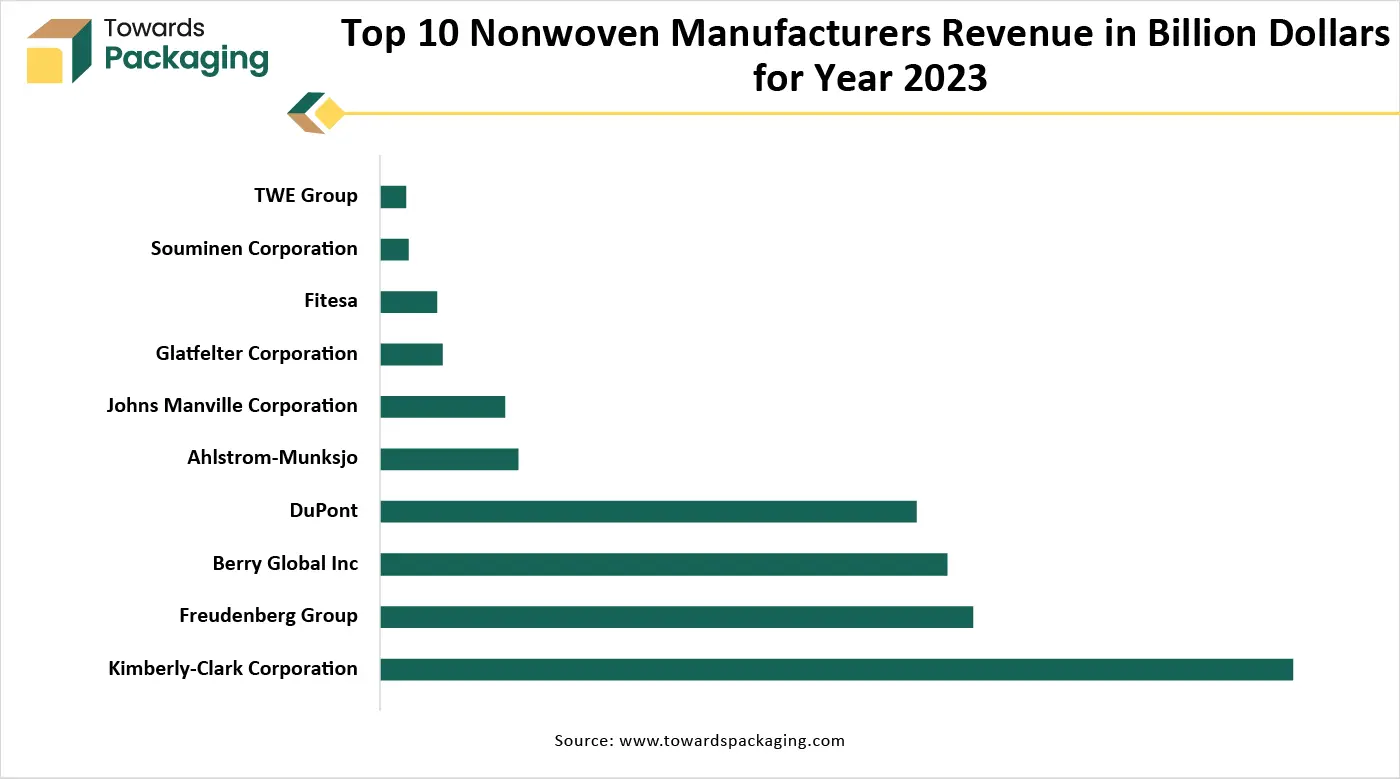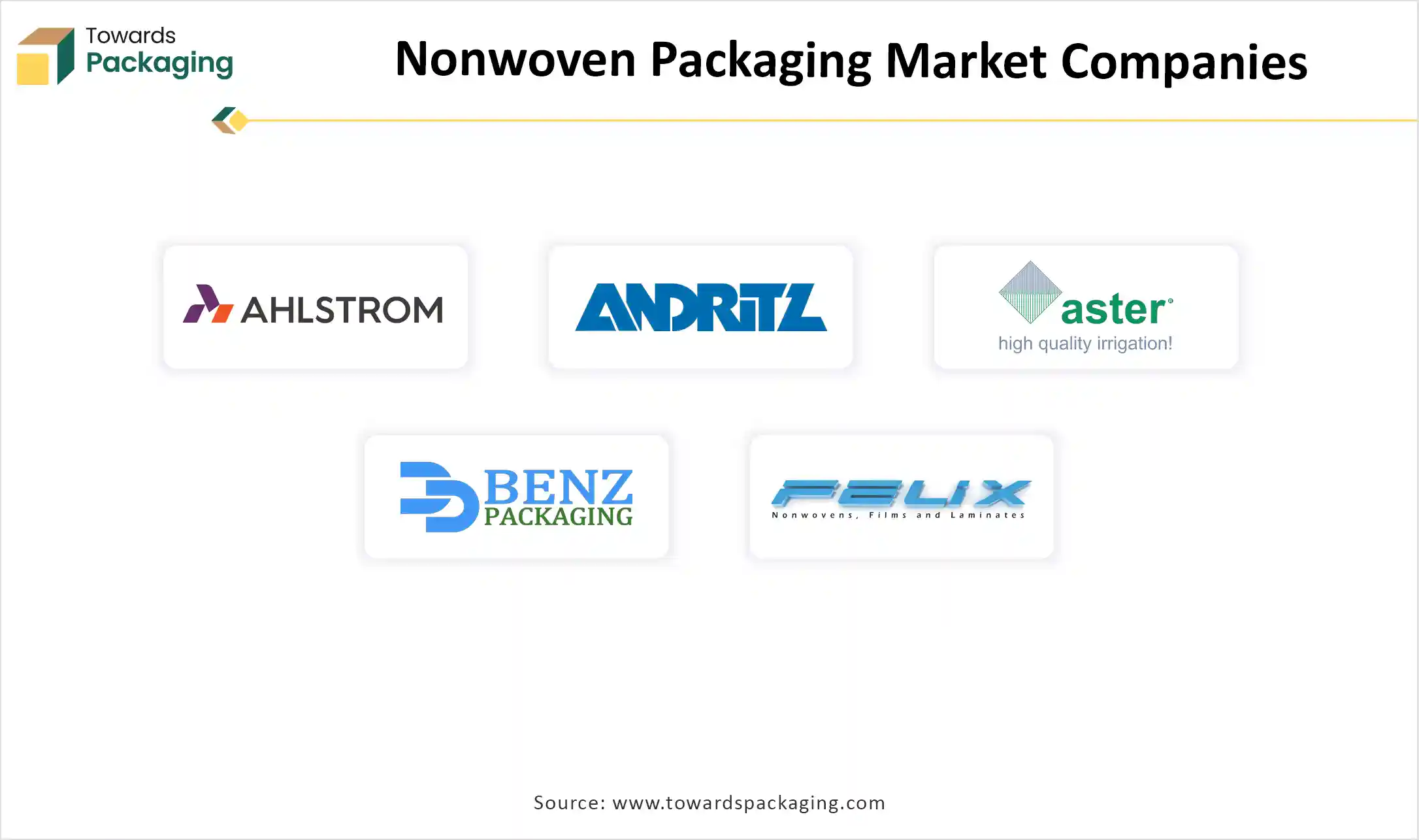April 2025
The nonwoven packaging market is projected to reach USD 7.98 billion by 2034, growing from USD 3.70 billion in 2025, at a CAGR of 8.9% during the forecast period from 2025 to 2034. This market is growing because nonwoven packaging is considered an alternative to single-use plastics. Many countries have banned the use of single-use plastics due to the increasing plastic waste and its harm to the environment. The growth of the nonwoven packaging market is driven by this factor; the shifting trend, improvements in technology, and manufacturing equipment will be the key attributes.

The global trend of sustainable packaging is the key driving factor of nonwoven packaging. The single-use plastic bags are highly convenient in retail shopping, but the biggest demerit of these bags is that they produce huge waste, which cannot be decomposed easily. Due to this, many countries have banned the use of single-use plastic. The most practical solution to this problem is the use of bags made from nonwoven materials.
Nonwoven materials are biodegradable, recyclable, and reusable. It is generally made using polypropylene (PP), which offers durability and strength. Huge demand from end users and the government is pushing forward the use of nonwoven packaging solutions. Food and beverages, healthcare, e-commerce & retail, and industrial markets are the key consumers of the nonwoven packaging due to its cost-effectiveness, high durability, and faster production ability.
The global e-commerce market reached $6.09 trillion in 2024, which is driving the nonwoven packaging demand. The use of nonwoven packaging is highly preferred in the healthcare industry, as nonwoven packaging is very cost-effective compared to packaging made from woven fabric.
In the healthcare industry, single-use packaging is preferred due to hygiene-related concerns, and the nonwoven packaging is easy to dispose which makes it the ideal choice for healthcare packaging applications.
AI has enhanced the production capability of the nonwoven packaging products due to industrial automation, and by reducing the labour cost. The effective strategy creation and implementation of effective waste management is very helpful. AI is providing optimized designs for the maximum usage of the material. The QR code and RFID integration in the nonwoven packaging enhance the consumer experience by creating an interactive experience for the consumer.
The AI in manufacturing can optimize the processes, detect defects using computer vision technology. With the help of AI, the integration of nanomaterials in the nonwoven packaging is possible, which can provide UV protection and enhanced barrier protection.
Integration of AI and robotics has automated all kinds of tasks in nonwoven packaging manufacturing, from material handling to bag creation, all can be handled with utmost precision and ultra-fast speed. The AI can be extremely useful in creating personalized designs based on customer requirements and choice.
The plastic takes a very long time to decompose, and pollutes the land and water bodies. As per UNEP estimation, 13 billion dollars’ worth of damage is caused by plastic to the marine ecosystem alone. Many countries' governments have imposed a direct ban on single-use plastic bags. These bags were extensively used in the retail market for carrying groceries, in medical shops, in clothing stores, supermarkets, and vegetable markets, everywhere to carry the goods.
But after a single use, there was no scope for the reuse of these bags, which were generating huge amounts of plastic waste and raising environmental concerns. The most suitable alternative for these carry bags made of plastic is the nonwoven bags, which are more durable than plastic. can be reused and repurposed, and are also cost-effective. End consumers are also showing a preference for the nonwoven bags due to their eco-friendliness and biodegradable features.

Many companies heavily use recycled materials to reduce the environmental strain by decreasing the use of virgin materials. Circular economy focuses on the recyclability and reusability of materials. The nonwoven packaging market has shown a shift towards the circular economy. The objective behind this is to utilize the resources efficiently while minimizing the material wastage. Advanced technology and processes are increasing the efficiency of the recycling operations, which is providing economic as well as environmental benefits. The global packaging market is rapidly adopting sustainable packaging solutions due to the stringent regulations and the end consumer demand, The nonwoven packaging market is seeing a massive opportunity in this wave.
Polypropylene (PP) dominated the nonwoven packaging market due to its features, such as versatility of applications, antimicrobial, and moisture-resistant properties. While being a lightweight material, the polypropylene (PP) can handle a significant amount of strain, and it also provides very effective protection against many chemicals. Polyester (PET) is the fastest-growing material in the nonwoven packaging market due to its high strength and durability. The high resistance of wear and tear makes it an ideal material for filtration and protective clothing. It is one of the most widely used materials in nonwoven packaging solutions.
Due to their versatile use, high durability, cost-effectiveness, sustainability, and attractive designs, the bags are dominating the product type segment. The nonwoven bags are the best alternatives for the single-use plastic carry bags. Non-woven bags are highly durable, reusable, and can handle more strain. The retail shops and e-commerce have shifted towards non-woven bags.
Many other industries, such as electronic packaging, have also shifted towards nonwoven packaging bags. Nonwoven wraps are the fastest-growing product type in the market, with various uses such as medical procedures, construction-related applications, and domestic household use. Wraps are insanely useful in wrapping goods during transportation and storage.
In the Spunbond process, thermoplastic polymers are bonded together, and the fabric is formed. This process provides the equilibrium of strength, durability, and cost-effectiveness at one point. This unique offering makes it a very suitable technology for nonwoven packaging, and makes it the popular choice in the nonwoven packaging market. Meltblown technology is the fastest-growing technology in the nonwoven packaging market. This growth is driven by the huge demand for filtration applications such as medical masks and industrial filters. This both spunbond and meltblown technologies have their qualities, which are having high demand in the current nonwoven packaging market.
The increasing shift towards eco-friendly packaging in the food and beverages market is increasing the demand for nonwoven packaging; in addition, stringent regulations by the government are also forcing companies towards the use of nonwoven packaging. The nonwoven packaging is very suitable for food packaging as it offers great antimicrobial properties, moisture resistance, and extended shelf life for the product.
The fastest-growing end-use segment is healthcare due to the increase in healthcare support demand as there is an increasing prevalence of diseases. Sterile and hygienic packaging for medical supplies, pharmaceuticals, and surgical products holds the major share in the nonwoven packaging for the healthcare industry. WHO and FDA have made it mandatory to use sterile and disposable packaging that is made using antimicrobial coatings and smart packaging solutions. All these factors are driving the growth of nonwoven packaging in the healthcare industry.
The highly penetrated packaged food and beverage market and the robust healthcare industry, and widespread E-commerce and retail in the North American market are driving the market growth in the region. The food and beverage sustainable packaging market in North America is valued at US$57.68 billion in 2024, which is going to drive the nonwoven packaging for food and beverages. The market is demanding lightweight, durable, recyclable, and reusable packaging solutions. The wave of eco-friendly materials and a ban on single-use plastics are the significant driving factors. In COVID-19, around 2,600 tons of waste were generated by the healthcare industry. Considering this large number healthcare industry decided to shift towards sustainable packaging solutions. Similarly, the food and beverage consumption generate approximately 1.05 billion tons of waste annually. Considering these massive numbers, authorities in the North American region are pushing the market towards sustainable packaging solutions.
The European population is one of the most educated and aware of the rising environmental concerns, and is actively seeking sustainable packaging solutions. The EU has also imposed a ban on single-use plastics, which is creating the demand for nonwoven packaging solutions in the European region. The European nonwoven packaging market generated USD 12.26 billion in 2024. The market is mainly driven by the healthcare, food, beverage, e-commerce, and retail sectors. Hygienic packaging solutions for the healthcare industry are the standard compliance by the authorities, leading to growth. Nonmicrobial and moisture-resistant packaging is enhancing the food and beverage packaging experience by increasing the shelf life of the food product
The Increasing population, rapid urbanization, rising e-commerce, and focus on sustainable packaging are the key aspects of the Asia-Pacific nonwoven packaging market. The market was valued at 11.8 billion dollars in 2024. Increasing demand for packaged food is generating the demand for nonwoven packaging. E-commerce companies are prioritizing the use of sustainable packaging solutions as part of a sustainable packaging initiative. The use of nonwoven packaging for traditional medicines and tea export is increasing due to its strength and moisture resistance properties. The electronics industry is considering nonwoven packaging due to its premium experience for electronics device packaging. Various smart packaging options are choosing nonwoven packaging due to its antimicrobial features. Grains, pulses, and spices packaging is highly reliant upon the moisture-resistant and durable nonwoven packaging solutions.
Latin America, the Middle East, and the African regions are demanding cost-effective, durable packaging solutions. The Latin American region is experiencing an emphasis on sustainable packaging options due to government regulations. The ban on single-use plastics in many countries is pushing the use of nonwoven packaging in industries such as retail shops, supermarkets, and food delivery.

By Material
By Product Type
By Technology
By End Use
By Region Covered
April 2025
April 2025
April 2025
April 2025